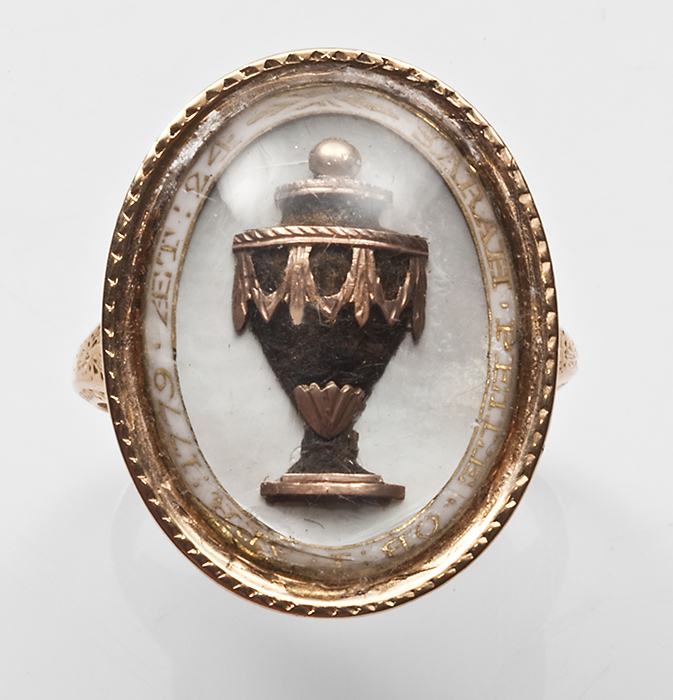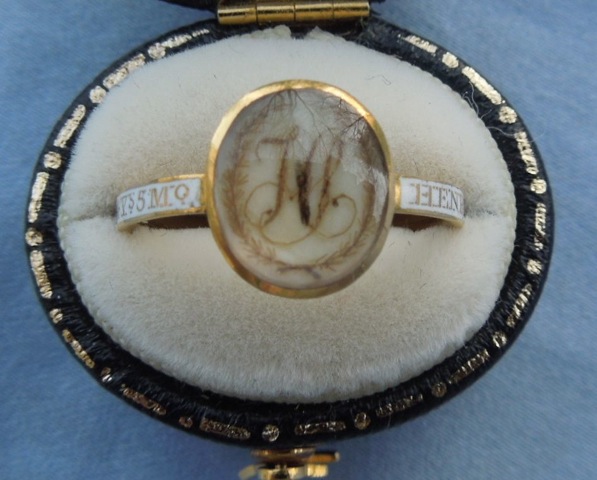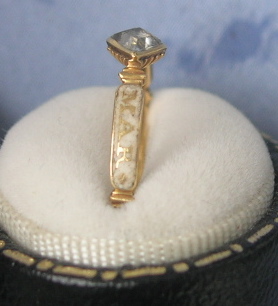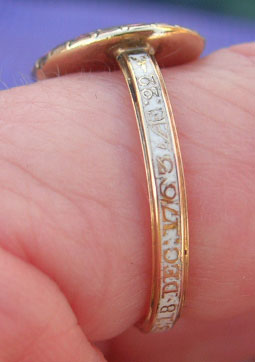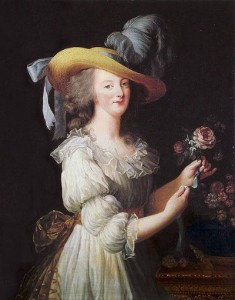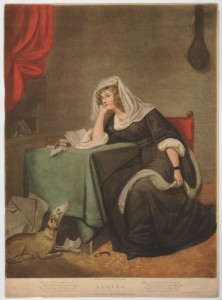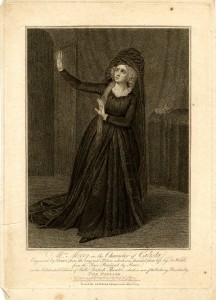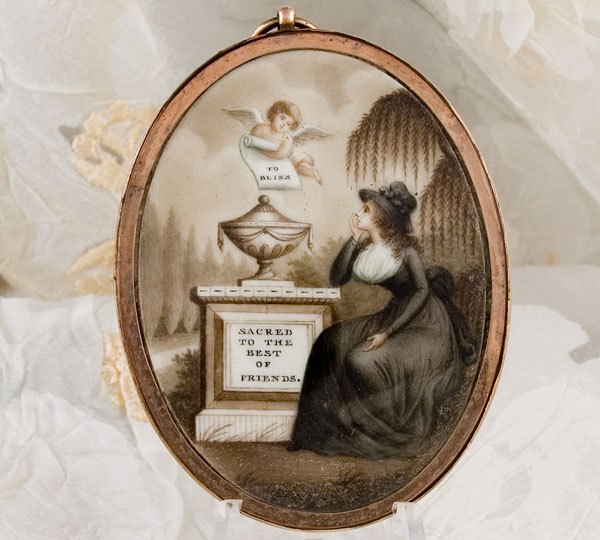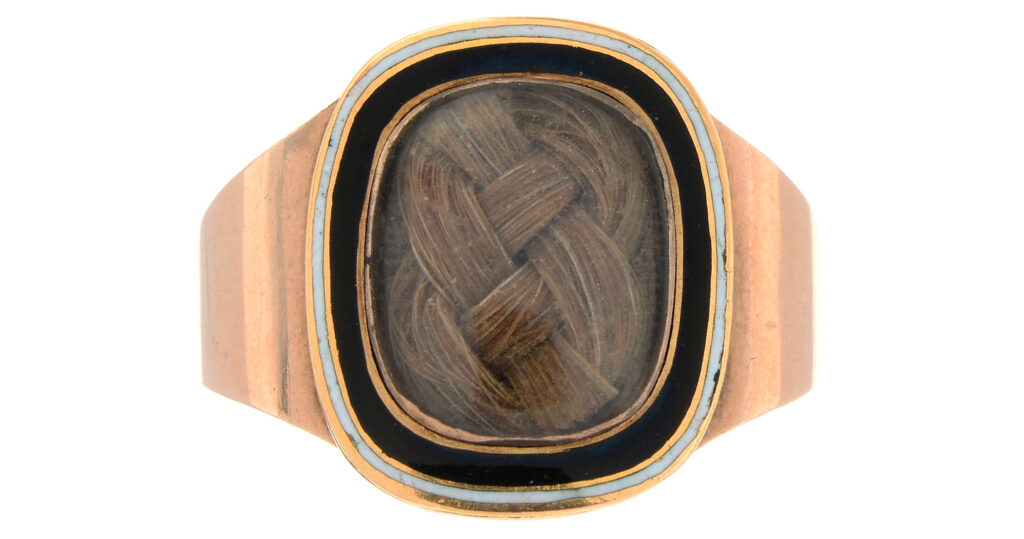1779 Pearlescent Urn Mourning Ring for Sarah Pettie
An urn is a vessel that holds the remains of a loved one and this ring for Sarah Pettie encapsulates her memory in the same representation. Created in 1779, this ring is the ideal symbol of mourning for a lady. Its use of white enamel and the mother of pearl base reflect various shades of white on white, signifying virginity and purity.
Presenting a ring like this commands a personal statement of grief and status for the late 18th century. Not only is it a piece that honours the popular sentimental motifs of the time (within the urn and the white enamel), but it also has a high level of quality within the three-dimensional urn. This urn is constructed over a metal base with crushed hair and comes at a time when the urn had hit its height of popularity within society. Being of the oval shape, the navette style (longer in its north to south presentation) had not come into popularity; this would come to prominence through the 1790s.
Sarah’s ring details the 1770s and 1780s with perfection. While in the above piece, the name and date of death are given around the border, the style of this began with the inception of the Neoclassical period and the oval shaped rings post 1765. As will be shown later in the article, the evolution of the writing in the border began with the writing around the band of a ring, an element which had its birth in the 17th century.
White Enamel
White enamel is the second most popular mourning material used, next to black enamel. Black enamel, being a colour that has represented death through to pre-history, was (and still is), the colour that was inlaid in jewels, most commonly with the ‘IN MEMORY OF’ sentiment. This was highly standardised by the 19th century, but in the 18th, there was much more flexibility with the use of sentiment and enamel colour.
Death, for its reasons of desecration and entrance into entropy, lead towards black, which in itself, is the absence of light. White, when in use, is the connection to purity, innocence and virginity, show the untarnished representation in colour towards a person’s morals and values. A young person who was not married was seen as unblemished in social status and the use of the white enamel to show this virtue is why white enamel is used in this context.
Colour and symbolism became the primary elements of the mid-18th century, with the introduction of the Rococo period and its infusion of naturalistic designs in jewellery. The previous Baroque period was notorious for its bolder, dominating design, however mourning jewels represent something far more personal than what could be reflected in grander statements of building and architecture.
Cost and the essential nature of wearing a mourning jewel requires that the wearer invest some intrinsic personal affectation into the jewel and that the jewel must reflect something of its time. The 18th century essentially established the industry of mourning, due in part to the Industrial Revolution and the rise of faster methods of production and a society which was becoming more and more mobile, with greater access to education and techniques.
In 1686, the revocation of the Edict of Nantes led to Huguenot goldsmiths and jewellers emigrating to Great Britain. This was when the previous allowance by Henry IV of France provided Calvinist Protestants (Huguenots) significant rights. With this retraction, the Huguenots bought with them skills which enabled the London trade to compete with Paris. This led to greater patronage with the influx of greater designs and new elements of fashion appearing as popular in jewels. By the mid 18th century, much of the values that were carried to Britain were instilled within the new industry and led to such elements as the Rococo designs in jewellery from its continental influence.
These new techniques applied to the white enamel that is displayed in Sarah’s 1779 ring. Not only did the inlay of enamel become a process which was being influenced by the influx of skills from the continent, but the styles that the Protestants introduced into England allowed for a cross-cultural sharing of new ideas. White enamel as a virtuous display of young life was becoming a mainstream consideration, which this run from 1699 shows.
After this influx of Huguenot talent, the mourning industry grew along with jewellery development. Mourning rings were flourishing under a stabilised government that had not been seen under the Interregnum (Cromwell) period, as well as the new wealth that was developing from the burgeoning Industrialisation movement. Comparing this ring from 1730 to the 1699 piece, there is a large degree of standardisation in the design elements. This is a ring produced after the various elements of mourning in jewellery had become common enough to interpret without being seen as a jewel for aesthetic purposes. This is clearly a ring made for the purpose of grief in the style of its time. Gone are the memento mori elements (though these were still fashionable, however they had become smaller in size) and introduced is the name and dedication of the ring written around the band.
This ring contains the last moments of the Baroque period, with the straight edged band and not the nature-inspired, Rococo elements that would dominate the following thirty years.
Here, the Rococo design elements have become the mainstream fashion in jewellery and the influence on mourning jewels shows. In the ribbon/scroll/twist motif, the ring is highly fashionable and utilises the memento mori skull underneath the crystal, which is almost a statement against its fashion. This is a ring made for death and grief, so any association with being part of the fashionable Rococo movement is not an attractive prospect.
A heavy relation to the Sarah ring from 1779 is seen once more in the white enamel and the development of the text around the band. As seen in the 1730 ring, all are standardising the sentimental dedication in the band, yet just adapting to whatever style was popular. With the message of the ring being so strong as to dominate the sentimental nature of the jewel, introducing a new style at the time would be contrary to what mourning regulation required. Mourning, at this time, was Court mandated and hence was a necessity within society to present oneself. Particularly when a young child or unmarried woman in a family has died, not utilising the white colour of the enamel would be considered inappropriate and a message to the values of the family.
For the purposes of creating a ring, unlike these bespoke rings with an individual dedication written into the bands, white enamel rings with ‘In Memory Of’ which have the written dedication inside the band, were not as common until the turn of the 19th century, when a century of building mourning style into the lexicon of mainstream society had cemented it as the requirement of a family. As it had become common, then a jeweller could pre-make several rings and have them ready for when wills required rings to be given out at a funeral.
Sarah’s 1779 ring is a close match to this piece from 1777. Here, the perfection of the Neoclassical period is captured with the depiction of the urn and weeping willow being superbly captured. Still with its crisp, sepia hues and exceptional focus on detail by the artist (note the source of the light from the left and the capturing of shadow to the right), the ring balances the style of the time with the white enamel band. The oval shape is another identifier that was popular from the 1770s to 1780s, with the larger, navette shape taking prominence throughout the 1790s. Much of this was due to the popularity of the Neoclassical symbols themselves. As these grew popular, so did the need to have a larger canvas to display more in a ring, pendant or bracelet clasp.
Past the Neoclassical period, the streamlined geometric styles that were popular in the Regency era had shown a cleaner design to the band, with the focus on font and a singular element being the most prominent element to the jewel itself.
Everything taken from Sarah’s ring is seen here at a latter date in popular, and sentimental, fashion. Combining the black and white enamel clearly denote the death of the loved one, but still show the purity of the person being mourned. By 1816, the Neoclassical period was being challeneged by the Gothic Revival, which was a swing back towards the simpler, ecclesiastical sensibilities of the middle ages. This reaction against the Neoclassical period and the excesses of the Regency was adopted by the Victorian era, yet all the elements of white enamel and the band with the surrounding dedication remained.
Fashion in the Late 18th Century
Finally, the fashion of the time was the grand statement with which the ring was worn. Why was sentimentality so united with fashion that a ring with hair in a display so large accommodated by society?
Post 1760, the Neoclassical movement had crept into the previously fashionable Rococo style of costume fabrics. Elaborate Rococo floral motifs moved to simple stripes or smaller motifs. Side hoops were discarded and lighter silks and cotton was introduced, with much influence being from the aristocracy. Marie Antoinette was painted in La reine en gaulle, by Elisabeth Vigée-Lebrun, 1783, introducing a new style that reflected the peasantry, showing a muslin chemise, straw hat and belt at the waist.
The 18th century welcomed in greater convention for mourning fashion and began to see the rise of the mourning industry. This became so much so that mourning dress was becoming desirable and the difference between mourning and non mourning dress was narrowing. Much of the fashion in this century was dictated by the fabric rather than the cut, and the silk industries in France and England held major influence on mourning wear because of this. It was Ordre Chronologique des Deuils de la Cour, (1765) where details of Court mourning in France were published, giving precise tailoring instructions. From their first days in mourning, men were permitted to appear in Court, unless it was after the death of a parent from whom they had received inheritance.
Widows had to wait one year and six weeks, with the first six months in black wool. Lord Chamberlain and Earl Marshall both ordered shorter periods of mourning in France and England respectively.
As in the 17th century, black and plain were required. Bombazine dresses trimmed in black crape, black silk hoods and plain white linen were worn with black shammy leather shoes, glove and crape fans. Jewellery was not permitted. Second mourning consisted of black dresses, trimmed with fringed or plain linen, white gloves, black or white shoes, fans and tippets and white necklaces and earrings as necessary. Grey lusterings, tabbies and damasks were acceptable for less formal occasions.
Ordre Chronologique des Deuils de la Cour was specific and influential enough to decide upon women’s fashions, as. It was specific enough to specify that; ‘dress was cut with a train and turned back with a braid attached to the side of the skirt, which was pulled through the pockets.’ This is where the overskirt is turned to the back and lifted up, revealing the petticoat underneath, called; robe retrousee dans les poche, the centre front robings were joined with hooks or ribbons. Cuffs were cut with one fold and deep hems, the waist was held in place by a crape belt that was tied on. This left two ends hanging down to the hem of the skirt.
A woman’s accessories were a crape shawl, gloves, shoes with metallic bronzed buckles, a black woollen muff and a black crape fan. Head dresses of black crape and white batiste were referenced. For much of the century, however, ‘paniers’ were fashionable, but in the French style, with loose pleating falling from the shoulders to the back. The English manner of this was with the back pleats stitched down as far as the waistline. Also popular were lace ruffles at the neck and the cuff, embroidered stomachers, silver gilt lace, appliqué work and small aprons. None of these were permitted for mourning wear. Mourning wear for women still remained consistent in that it remained plain, black or sometimes white fabric.
The Urn
The major focal point of this ring is the urn itself. This is the true identifier of the ring; being the vessel that is literally made from the remains of Sarah. Her hair is represented being roughly chopped and mixed with glue to create a high-relief urn, surrounded by the draped and decorated urn motifs. The urn itself is a vessel, or more specifically a vase, which naturally have their beginnings in pre-history when humanity began gathering items in order to carry them. We won’t be dwelling on this form of history, but rather the ancient Greek use of the urn in artistic depictions. The urn itself had evolved as a decorative item, often with art displayed upon the vessel itself prior to Greece in neighbouring Mediterranean societies, but its interpretation in jewellery design stems mostly from the Greek and Roman scenes in art and their reinvention during the Neoclassical period.
Usage of the urn had never wavered, however. Cremation of the body and the collection of ashes in the urn is a method that survived ancient civilisations well into the Dark Ages. The name itself is derived from the Latin ‘uro’, meaning ‘to burn’, so no matter what the shape of the vessel the title was always ‘urn’. This is a concept that never left the mainstream mind and its uptake as a Neoclassical symbol and its consistency as a funerary motif is simply a natural evolution for the urn’s depictions.
While burial became the more popular method of interment, the urn still retained its status as a symbol of death, testifying the death/decay of the body and into dust and the departed spirit resting with god.
Draped urns are another variation of the popular symbol in the Neoclassical period. The draped urn itself often denotes the death of an older person, however, the drapery is often a constant when in relation to death. Interpretations of this can be when the shroud drapery denotes the departure of the soul towards heaven in relation to the shroud over the body, the drape is the partition between life and death or that it is guarding the sacred contents of the urn itself. In jewellery, finding the urn draped or undraped is quite common, but why is it so?
The urn is a motif that reached incredible heights of popularity in Neoclassicism due to its interpretation from the original classical depictions. It was a motif that was easily lifted from its source and fulfilled all the classical resonance that a revival period needed to convey the style of its respective era. With the focus back upon the personal nature of mourning and the departure of the direct link towards god, death itself became something worn prominently in mainstream fashion. The urn was a perfect way to show this, draped or undraped. Sitting on top of a plinth, column or tomb, the urn is often the central focus of the mourning depiction. The mourning character in the depiction (male or female) is often interacting with the urn in some way, either leaning against it weeping, sitting near it, standing beside it or looking at it directly. This links the personal nature of mourning from the person into the jewel itself. The mourner is the wearer or the person who created the dedication and the urn represents the loved one. Consider that; there’s a direct link in methodology of the urn to the self, this is why the urn is the central motif and not the mourner.
Consider that when looking at a brooch, ring, bracelet clasp, pendant or any other peripheral from the late 18th to early 19th centuries. The urn is the concept that should draw the eye and take precedence over everything else.
The symbol disappeared soon after the first quarter 19th century in mourning jewels, but was retained within funerary art. The Gothic Revival period played a key role in reverting society back to more ‘traditional’ values. Using a direct relation to the body in the urn conflicts with the burial/god connection which was part of the social understanding of life and death, that Christian values returned to a life under god.
You can find the urn in use to around the 1820s, but many of the latter uses in jewels are anachronistic in the same way that memento mori would have been during the late 18th century. However, in funerary, the urn was still retained and is to this very day. In fact, its use in architecture in the latter 19th century / early 20th century was quite typical, but it had largely disappeared as a motif to represent the self in mourning.
Sarah’s ring from 1779 upholds the values of the urn, but also infuses the symbol with the body itself. Utilising the hair within the ring makes the value of the piece literal in the vessel which holds the body. With the shift to the identity of the self being as important as the soul resting with God, this ring is the remains of Sarah herself, which are encapsulated in a piece the family could wear. Hair crushed into sepia paint was not uncommon for the times, but seeing the larger strands of hair in thicker style brings the modern viewer even closer to the subject. This isn’t simply an excessive flourish; the urn is Sarah herself.
Purity
Mourning rings, being written into wills and dedicated to friends and family, are symbols of a life lived. When a white enamel ring appears, the intonation of a life not fulfilled is suggested, meaning that the young or unmarried have passed away before their time. From the perspective of being created before the expected mortality was yet to arrive, they represent jewels created quickly or bespoke for the moment; capturing the popular element and design for their times. Mourning, in these instances, becomes more immediate for modern viewers. Jewels are created for their essence of immediate love, so the thought and craft that goes into a white enamelled jewel is truly of its time and moment.




